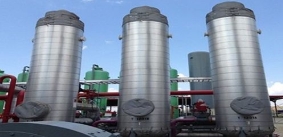
The contract announced today for $1.1 million expands on the original project announced by PyroGenesis on June 11, 2024 (“PyroGenesis Signs Contracts Totaling $2.5 Million to Deliver Greenhouse Gas-Reducing System for Major North American Biofuel Project”), whereby the Company was contracted to engineer, design, and fabricate a thermal swing adsorption (“TSA”) system for the dehydration of pure oxygen produced from electrolyzers at the VCR plant. Under the terms of the new project, the Company will provide additional engineering, technology services and equipment related to a nitrogen loop system, whereby nitrogen would be fed into the system to regenerate the system. Together, this would target the necessary requirement and quality of the eventual product gas.
“As I stated back in June 2024 upon the awarding of the original contract, we were looking forward to potentially increasing our role as the project evolves. This $1.1 million follow-up contract is testament to our efforts to provide high quality engineering and technology that makes customers in some of the world’s most impactful projects take notice,” noted P. Peter Pascali, President and CEO of PyroGenesis. “Our technologies such as thermal swing adsorption and pressure swing adsorption that capture and recover CO2 and other greenhouse gas emissions during biofuel production, are key to expanding the energy grid while reducing hazardous emissions. The VCR project has a stated goal of cutting more than 170,000 tonnes of greenhouse gas emissions annually and 4.25 million tonnes over the project’s 25-year lifespan.1 This is equivalent to permanently removing 50,000 passenger vehicles off the road.”
The $1 billion VCR project is being led by a consortium of major corporate partners, including Shell, Suncor, Proman, and Enerkem, and has the financial backing of the Quebec and Canadian governments. This consortium is constructing Canada’s largest biorefinery with a capacity to convert up to 200,000 tonnes of non-recyclable waste and residual biomass material into 125 million liters of commonly used chemicals and value-added biofuels, such as methanol. The plant will be powered by clean electricity and will leverage renewable green hydrogen and oxygen produced onsite by one of the world’s largest electrolyzers.
Technologies such as thermal swing adsorption and gas separation system technologies, are part of the Company’s three-tiered solution ecosystem that aligns with economic drivers that are key to global heavy industry. Thermal swing adsorption and gas separation systems are part of the Company’s Energy Transition & Emissions Reduction tier, where gas purification, separation and conversion technologies, and fuel switching utilizing the Company’s electric-powered plasma torches, helps heavy industry reduce greenhouse gas emissions and fossil fuel use. The other tiers are Waste Remediation, and Commodity Security and Optimization.